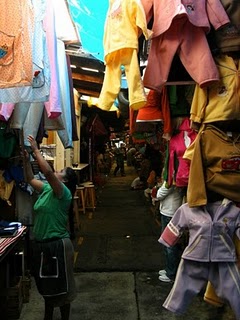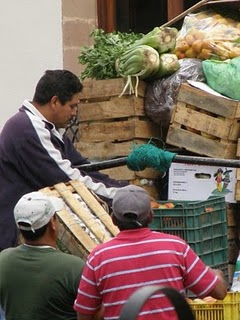by Reed Brundage
Shopping Town: U.S. Culture Seen Through a Mexican Lens
Returning recently to the U.S. from Mexico and staying at a hotel in a Chicago suburb, I was struck at a visceral level by the dramatic contrasts between that world and the world where I now live in Mexico. Put differently, I not only saw but felt the differences in my body.
I was acutely aware of how the humanly constructed environment, el medio ambiente, communicates the primary cultural values of a society and shapes our experience, actions, values and worldview.
Cultural Environment
Our cultural environment is not something separate from us. It is like the air we breathe. We absorb it, and it becomes indistinguishable from our very selves. The relationship is symbiotic, mutually self-sustaining.
This post is an effort to illustrate, through one example, some of the differences in cultural environment between Mexico and the U.S. and to communicate how our environments shape who we are. The contrasting experiences are conveyed by photos taken from both worlds—both cultures.
Mexico is grounded in two what may be called ‘classical’ cultures: the Mesoamerican culture that developed in the center of what is now the Americas over the course of more than three thousand years, and the Spanish culture that developed in Europe on a foundation of millennial-old Mediterranean cultures.
While there are great differences between the two cultures, there are also similarities. Mexican culture is a fusion of the two.
Cultural Space and Time: History
The most basic elements of cultural environment are those that define where we are in cultural time and space. These dimensions serve to locate us in a particular history. In Mexico, both its indigenous and Hispanic cultures have organized cultural space around a clearly defined centro, defined by structures that embody the religious and political powers at the heart of the culture.
In Mesoamerican culture, these centros are public gathering spaces dominated by pyramids. In the Hispanic culture of colonial Mexico, el Centro is a public plaza delineated by the town’s principal Catholic church on one side and government offices on the other. In such a space, you always know where you are—both physically and culturally.
 |
| Pyramids of the Purhépecha people at Ihuatzio, Michoacán |
 |
| Plaza Vasco de Quiroga, Pátzcuaro, Michoacán |
Shoppingtown would like you to believe that you are in the center of some ideal small town, but in no particular time or place. Its main street is decorated with various cultural symbols that refer to a number of different historical times and places.
 |
| French fountain with Egyptian sphinx-like lions |
 |
| Sundial with Greek symbols of the Zodiac |
Space and Time in Mesoamerica
Mesoamerican cities were intentionally designed as cultural environments according to a plan. Actually, the plan was cosmic in the sense that it recreated on earth the space and time dimensions of the Mesoamerican cosmovision, thus enabling all community members to locate themselves in relation to the center of their cultural universe.
Two dimensions determined the center. A vertical axis, centered on the pyramid, connected the everyday, horizontal, terrestrial world to the gods in the Heavens above and the Underworld below.
The four cardinal directions, radiating out from the center, located people within the horizontal plane of the earth. Each direction was identified by a color and associated with a particular god who ruled over it.
 |
| Mayan World Tree, rising vertically from the Underworld, passes through the horizontal, terrestrial plane to reach the Heavens. |
- Red for the East, where the sun rises,
- Yellow for the South, where the sun resides,
- Black for the West, where the sun passes into the night, and
- White for the North, where it is cold because of the absence of the sun.
Space and Time in Shoppingtown
In contrast, the builders of Shoppingtown want to be sure that you know not so much where you are as how to get where you (and they) want (you) to go—hence signposts.
A map not only helps visitors find their way, but it also presents the overall design of this cultural space.
Eerily, Shoppingtown’s design mirrors the design of Mesoamerican cities. The Center is occupied, not by a temple of the gods, but by Macy’s—a ‘temple of commerce’. The four cardinal directions (more or less) are marked with colors that identify four parking garages, and the entrance gates through which visitors must enter this ‘town’, and which they must be able to locate when they want to leave.
Other renowned ‘temples of commerce’ mark the four cardinal directions: Bloomingdale’s to the North, Lord & Taylor to the East, and Nordstrum’s to the South.
And just as Shoppingtown has no real cultural location, nor does it exist in any continuous historical time. Yes, it exists in the contemporary, late twentieth to early twenty-first century United States, but nothing appears in Shoppingtown that connects it with any real past or geographic location.
Many of the Main Streets of small U.S. towns show their history, even if it is only to the nineteenth century. The Main Street of Danbury, Connecticut, where we last lived in the U.S., retains its Victorian character in its ornate, orange-brick facades. But Shoppingtown has been un-moored from these cultural underpinnings.
The pseudo-historical references decorating Shoppingtown’s Main Street are over-ridden by the architecture of the shopping center, whose geometric modernism presents space and time as mathematical, ahistorical abstractions. Straight lines, angles, squares, and cubes of steel, stone and glass create an anonymous and timeless space.
The stores themselves are equally impersonal, communicating a freedom—or perhaps a disconnect—from time and place.
Compare this timeless, impersonal anonymity with what might be called the ‘shopping center’ of Pátzcuaro, el mercado.
 |
| The wide, covered Portal is lined with vendor's stalls, called puestos |
 |
| Clothes Stall (Puesto) |
 |
| Shoe Stall |
 |
| Unloading Fruits and Vegetables |
Now consider this reaction when I took a picture inside of Macy’s.
This man told me that no one was allowed to take pictures of the inside of the store. I asked, “Why?” His response was, “Because of the competition.”
As I left, he also came outside for a smoke—by himself.
In Pátzcuaro’s mercado, going out by yourself for a smoke—or for anything else, for that matter—would hardly ever happen.
In Pátzcuaro as anywhere else in Mexican culture, place, time and people (el pueblo) are inseparable, interrelated, interconnected. El pueblo refers both to a people and their place, located within a continuous, acknowledged history.
In Shoppingtown, there are no connections to any of these concrete, cultural, historical human realities. So as you leave this place that is No Where and of No Time, where No One lives, you are reminded:
Postscript: Fall 2011
As many of you already know, Reed and I moved from Pátzcuaro, Michoacán, to Coyoacán, Mexico City, in August 2011. We would be less than truthful if we failed to mention that 'Shoppingtown' has arrived here.
Mexican Shopping Malls are almost indistinguishable from those in the U.S. We even shop there sometimes. But in Mexico the malls, which are humongous, coexist with many traditional mercados. Some are weekend markets, but others operate full-time. Mexico remains ... inimitably, México.












No comments:
Post a Comment